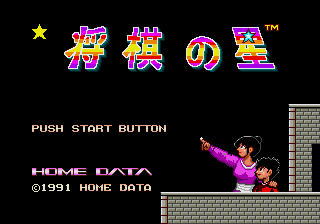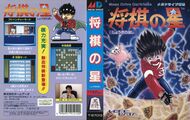Difference between revisions of "Shougi no Hoshi"
From Sega Retro
(trivia section destroyed) |
|||
| Line 18: | Line 18: | ||
'''''{{PAGENAME}}''''' (将棋の星) is a 1991 game for the [[Sega Mega Drive]] by [[Home Data]] released only in Japan. The game is an implementation of the Japanese board game [[wikipedia:Shogi|shogi]], with the notable inclusion of mannerisms (such as a character which flips off the camera). | '''''{{PAGENAME}}''''' (将棋の星) is a 1991 game for the [[Sega Mega Drive]] by [[Home Data]] released only in Japan. The game is an implementation of the Japanese board game [[wikipedia:Shogi|shogi]], with the notable inclusion of mannerisms (such as a character which flips off the camera). | ||
| − | This would be one of many shogi simulation games by Home Data. The game was designed by a "K. Miyahara" (a photo of whom is featured on the back of the game's packaging). He was influenced by the anime ''[[wikipedia:Kyojin no Hoshi|Kyojin no Hoshi]]'', as there are many references to the show in the game. In addition, the game's title screen music is an instrumental version of the opening theme from the anime. | + | This would be one of many shogi simulation games by Home Data. The game was designed by a "K. Miyahara" (a photo of whom is featured on the back of the game's packaging). He was influenced by the anime ''[[wikipedia:Kyojin no Hoshi|Kyojin no Hoshi]]'', as there are many references to the show in the game. In addition, the game's title screen music is an instrumental version of the opening theme "''Yukeyuke Hiyuuma''" from the anime, as well as Kinta's mother being named Ittetsuko Hoshi, in reference to the protagonist's father in ''Kyojin no Hoshi'', Ittetsu Hoshi. |
| − | This was the only shogi simulation game released for the Mega Drive. This also goes for chess games of any type (not counting unofficial games and the ones released exclusively for the [[Sega Channel]] service. | + | This was the only shogi simulation game released for the Mega Drive. This also goes for chess games of any type (not counting unofficial games and the ones released exclusively for the [[Sega Channel]] service). |
==Story== | ==Story== | ||
| Line 28: | Line 28: | ||
There are two modes of gameplay, the Adventure Mode, and the Standard Shogi Mode, the latter of which is an exhibition game with an AI opponent of varying levels. Unfortunately, a two-player mode is not available. | There are two modes of gameplay, the Adventure Mode, and the Standard Shogi Mode, the latter of which is an exhibition game with an AI opponent of varying levels. Unfortunately, a two-player mode is not available. | ||
| − | In the Adventure Mode, | + | In the Adventure Mode, the player must go up against five opponents; Hida Takayama, Keima Ittou, Sister Okyou, Ryuukaku-san, and finally the Great King. Because the game does not have a save feature, the Adventure Mode must be beaten in one sitting. If the player loses, they can try again after solving a Tsume Shogi problem, varying from 3, 5, or 7 moves. If the player beats an opponent, they can select one of three chests which rewards them with a power-up they can use during a game. When the later enemies are put in Check, they will use their own power-up, which usually allows them to make two moves in a row. |
{{A}} or {{C}} selects a piece to move, {{B}} selects a piece that you captured to put into the board and {{Start}} opens a menu of tricks (but does not pause the game time, however). | {{A}} or {{C}} selects a piece to move, {{B}} selects a piece that you captured to put into the board and {{Start}} opens a menu of tricks (but does not pause the game time, however). | ||
| + | |||
| + | The opponents' names all reference different Shogi pieces; Hida Takayama (飛田 高山) references the Rook (飛), Keima Ittou (桂馬 一刀) references both the Knight (桂) and Promoted Bishop (馬), Sister Kyou (シスター お香) references the Lance (香), Ryuukaku-san (竜角さん) references both the Promoted Rook (竜) and Promoted Bishop (角), and the Great King (大王) references the King (王). | ||
==Production credits== | ==Production credits== | ||
| Line 41: | Line 43: | ||
*'''Music Program:''' Junichi Ueda | *'''Music Program:''' Junichi Ueda | ||
*'''Special Thanks To:''' Fujishima, Miao | *'''Special Thanks To:''' Fujishima, Miao | ||
| − | | source=In-game credits (JP) {{ref|1=https://www.youtube.com/watch?v=EskuFoBVtWI&t=76s}} | + | | source=In-game credits (JP){{ref|1=https://www.youtube.com/watch?v=EskuFoBVtWI&t=76s}} |
| console=MD | | console=MD | ||
}} | }} | ||
| − | |||
| − | |||
| − | |||
| − | |||
| − | |||
| − | |||
==Magazine articles== | ==Magazine articles== | ||
Latest revision as of 20:32, 31 October 2024
| Shougi no Hoshi | ||||||||||
|---|---|---|---|---|---|---|---|---|---|---|
| System(s): Sega Mega Drive | ||||||||||
| Publisher: Home Data | ||||||||||
| Developer: Home Data | ||||||||||
| Sound driver: SMPS Z80 | ||||||||||
| Genre: Table[1] (shogi) | ||||||||||
| Number of players: 1 | ||||||||||
| Official in-game languages: | ||||||||||
|
Shougi no Hoshi (将棋の星) is a 1991 game for the Sega Mega Drive by Home Data released only in Japan. The game is an implementation of the Japanese board game shogi, with the notable inclusion of mannerisms (such as a character which flips off the camera).
This would be one of many shogi simulation games by Home Data. The game was designed by a "K. Miyahara" (a photo of whom is featured on the back of the game's packaging). He was influenced by the anime Kyojin no Hoshi, as there are many references to the show in the game. In addition, the game's title screen music is an instrumental version of the opening theme "Yukeyuke Hiyuuma" from the anime, as well as Kinta's mother being named Ittetsuko Hoshi, in reference to the protagonist's father in Kyojin no Hoshi, Ittetsu Hoshi.
This was the only shogi simulation game released for the Mega Drive. This also goes for chess games of any type (not counting unofficial games and the ones released exclusively for the Sega Channel service).
Contents
Story
Kinta Hoshi (星金太) is the main character of the game. His name is a reference to the titular "Hoshi" (star), as well as the Gold General (金) in Shogi. His father was a part of the Underground Shogi Syndicate, and was the boss's right-hand-man. Upon trying to leave, he was apparently murdered. 10 years later, Kinta receives strict discipline by his mother Ittetsuko Hoshi including not letting him in the house until he masters the special moves of Shogi. It turns out she's training Kinta so he can go after the boss of the Underground Shogi Syndicate.
Gameplay
There are two modes of gameplay, the Adventure Mode, and the Standard Shogi Mode, the latter of which is an exhibition game with an AI opponent of varying levels. Unfortunately, a two-player mode is not available.
In the Adventure Mode, the player must go up against five opponents; Hida Takayama, Keima Ittou, Sister Okyou, Ryuukaku-san, and finally the Great King. Because the game does not have a save feature, the Adventure Mode must be beaten in one sitting. If the player loses, they can try again after solving a Tsume Shogi problem, varying from 3, 5, or 7 moves. If the player beats an opponent, they can select one of three chests which rewards them with a power-up they can use during a game. When the later enemies are put in Check, they will use their own power-up, which usually allows them to make two moves in a row.
![]() or
or ![]() selects a piece to move,
selects a piece to move, ![]() selects a piece that you captured to put into the board and START opens a menu of tricks (but does not pause the game time, however).
selects a piece that you captured to put into the board and START opens a menu of tricks (but does not pause the game time, however).
The opponents' names all reference different Shogi pieces; Hida Takayama (飛田 高山) references the Rook (飛), Keima Ittou (桂馬 一刀) references both the Knight (桂) and Promoted Bishop (馬), Sister Kyou (シスター お香) references the Lance (香), Ryuukaku-san (竜角さん) references both the Promoted Rook (竜) and Promoted Bishop (角), and the Great King (大王) references the King (王).
Production credits
- Planning: K. Miyahara
- Director: Miyazee (K. Miyahara)
- Program Design: Yi Wu, Ofu (Masahiro Kobayashi), Earlo
- Graphics Design: Miyazee (K. Miyahara)
- Music Compose: Novuko Hasebe (Novko Hasebe)
- Music Program: Junichi Ueda
- Special Thanks To: Fujishima, Miao
Magazine articles
- Main article: Shougi no Hoshi/Magazine articles.
Physical scans
| Sega Retro Average | ||||||||||||||||||||||||||||||||||
|---|---|---|---|---|---|---|---|---|---|---|---|---|---|---|---|---|---|---|---|---|---|---|---|---|---|---|---|---|---|---|---|---|---|---|
|
| 56 | |
|---|---|
| Based on 6 reviews | |
Technical information
- Main article: Shougi no Hoshi/Technical information.
References
- ↑ 1.0 1.1 https://sega.jp/history/hard/megadrive/software_l.html (Wayback Machine: 2020-07-02 23:21)
- ↑ https://www.youtube.com/watch?v=EskuFoBVtWI&t=76s
- ↑ 1700 igr dlya Sega, "" (RU; 2001-xx-xx), page 271
- ↑ Beep! MegaDrive, "November 1991" (JP; 1991-10-08), page 38
- ↑ Famitsu, "1991-11-08" (JP; 1991-10-25), page 37
- ↑ Hippon Super, "September 1991" (JP; 1991-08-03), page 91
- ↑ Mega Drive Fan, "January 1992" (JP; 1991-12-07), page 101
- ↑ Sega Saturn Magazine, "September 1995" (JP; 1995-08-08), page 87
| Shougi no Hoshi | |
|---|---|
|
Main page | Magazine articles | Reception | Region coding | Technical information | |


